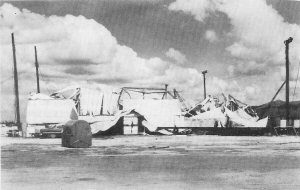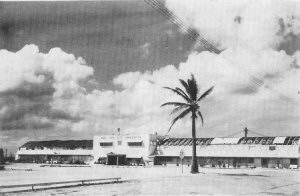As the wind velocity increased steadily Sunday, NSD shifted its Control Center from the Administration Building (which was de-roofed later that night) to the typhoon-proof Technical Stores Warehouse in the water-front area. Command Post II was established in the Provisions Division Warehouse and III at the Fuel Department. All the gear and records necessary to weather a typhoon, and afterwards, get the Depot back into operation quickly, had been pre-positioned.


NSD ADMIN (right) personnel were forced to evacuate to the Technical Stores Warehouses as the intensity of Typhoon Karen's winds mounted. Fortunately no one was injured, but nearly the entire roof of the building was wrenched-off by the storm. (VAP-61 Photo)
About 1830 they lost all electrical power in Command Center and were forced to utilize battle lanterns and flashlights in order to see. The loss of power eliminated two high frequency radio nets which were the primary means of communication with Command Posts II and III, forcing reliance on telephones and land lines for communications.
Telephones Out
As wind velocity increased, the telephones went out. At this point the only means of communication were land lines to Command Posts II and III. Later the Command Posts also lost power and phones. The wind and rain finally knocked out land lines which were the only means of communication with areas outside Command Center.
The commanding officer directed the Disaster Control officer to advise him when it was considered safe to send a survey party out to estimated damages to NSD property and report this condition to ComNavMar. At about 0200 Monday, the winds had decreased to approximately 45 knots so a damage survey party was dispatched in a mobile radio truck. Constant communications were maintained by using a second mobile radio truck at the Command Center as a base for communications.
Debris Observed
As this truck left the Command Center, large quantities of debris were observed. Corners of buildings, portions of roofs, pieces of sheet metal were strewn about the area as if it were a junk yard open for business. Trees were uprooted and utility poles were down. The inspection tour was forced to turn back at one point due to numerous electrical lines dangling across the road. While trying to evade them, the truck became entangle with a section of line and some nervous minutes elapsed until another route was found.
All permanent structures were reported to be in good condition; however, most sheet and wooden buildings were blown down or severely damaged. Several perimeter fences were blown down and many power poles were snapped like match sticks while others were careening wildly. The truck reached the PWC Command Post safely and reported all NSD permanent type warehouses withstood the typhoon and the Depot was ready to commence issuing emergency typhoon recovery equipment and supplies.
Structures Inspected
On the way back to the NSD Command Center, temporary structures were inspected. The Administration Building had been decapitated. Its roof had been carried away, leaving the interior to the mercy of the high winds and torrential rains. The Disposal Department main building was a stark, gaunt skeleton against the sky. Material handling equipment and repair buildings were made roofless and crushed by the storm.
After the inspection, the truck reported back to the Command Center where it was once again dispatched to inspect the Provisions Warehouse and Fuel Farm area. These areas, composed of permanent structure buildings, had received slight damage. However, one of the large steel reinforced concrete provisions warehouses had lost a portion of its roof. A 20' x 5' concrete slab weighing several tons had been tossed about 25 feet by the driving wind, causing a considerable hole to appear where it came to rest farther down the roof.
Moved to First Deck
By first light November 12 NSD working parties were at the Administration Building moving office machines, official records, supplies and office furniture down to the first deck so they would be out of the lashing rain. Working parties were issuing provisions and supplies to other commands for use in Typhoon Karen recovery operations. By 0730 fifty per cent of the civilian employees had joined the military personnel already on duty and were engaged in recovery and issue operations.
An inspection of material exposed to the elements revealed little or no damage. Stock record cards which were located on the first deck of the now roofless Administration Building were intact. Central files which were located on the second deck were expose to wind and rain: however, they had been well secured and were only slightly damp.
Relocation
An inspection of material exposed to the elements revealed little or no damage. Stock record cards which were located on the first deck of the now roofless Administration Building were intact. Central files which were located on the second deck were exposed to wind and rain: however, they had been well secured and were only slightly damp.
Designated Coordinator
CAPT Alfred C. Jackson, commanding officer, NSD, was designated coordinator for all requests for off-island typhoon emergency supplies by ComNavMar. Message requisitions were sent to NSD Yokosuka, NSC Pearl Harbor, Sharpe General Depot, NSC Oakland. ComServPac and CincPacFlt for additional emergency supplies.
NSD, even though severely disrupted and relocated, is working in full swing, engaged in a twenty-four hour, seven-day a week, and will probably run at this tempo for a while. Moral is high as all NSD employees continue to give the best possible service under most trying circumstances.

